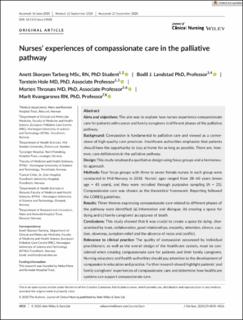| dc.contributor.author | Tarberg, Anett Skorpen | |
| dc.contributor.author | Landstad, Bodil J. | |
| dc.contributor.author | Hole, Torstein | |
| dc.contributor.author | Thronæs, Morten | |
| dc.contributor.author | Kvangarsnes, Marit | |
| dc.date.accessioned | 2021-04-26T13:43:13Z | |
| dc.date.available | 2021-04-26T13:43:13Z | |
| dc.date.created | 2020-11-06T12:52:57Z | |
| dc.date.issued | 2020 | |
| dc.identifier.citation | Journal of Clinical Nursing (JCN). 2020, 29 (23 -24), 4818-4826 . | en_US |
| dc.identifier.issn | 0962-1067 | |
| dc.identifier.uri | https://hdl.handle.net/11250/2739700 | |
| dc.description.abstract | Aims and objectives
The aim was to explore how nurses experience compassionate care for patients with cancer and family caregivers in different phases of the palliative pathway.
Background
Compassion is fundamental to palliative care and viewed as a cornerstone of high‐quality care provision. Healthcare authorities emphasize that patients should have the opportunity to stay at home for as long as possible. There are, however, care deficiencies in the palliative pathway.
Design
This study employed a qualitative design using focus groups and a hermeneutic approach.
Methods
Four focus groups with three to seven female nurses in each group were conducted in Mid‐Norway in 2018. Nurses’ ages ranged from 28–60 years (mean age = 45 years), and they were recruited through purposive sampling (N = 21). Compassionate care was chosen as the theoretical framework. Reporting followed the COREQ guidelines.
Results
Three themes expressing compassionate care related to different phases of the pathway were identified: (a) information and dialogue, (b) creating a space for dying and (c) family caregivers’ acceptance of death.
Conclusions
This study showed that it was crucial to create a space for dying, characterized by trust, collaboration, good relationships, empathy, attention, silence, caution, slowness, symptom relief and the absence of noise and conflict.
Relevance to clinical practice
The quality of compassion possessed by individual practitioners, as well as the overall design of the healthcare system, must be considered when creating compassionate care for patients and their family caregivers. Nursing educators and health authorities should pay attention to the development of compassion in education and practice. Further research should highlight patients’ and family caregivers’ experiences of compassionate care and determine how healthcare systems can support compassionate care. | en_US |
| dc.language.iso | eng | en_US |
| dc.publisher | John Wiley & Sons Ltd. | en_US |
| dc.relation.uri | https://onlinelibrary.wiley.com/doi/10.1111/jocn.15528 | |
| dc.rights | Navngivelse 4.0 Internasjonal | * |
| dc.rights.uri | http://creativecommons.org/licenses/by/4.0/deed.no | * |
| dc.title | Nurses' experiences of compassionate care in the palliative pathway | en_US |
| dc.type | Peer reviewed | en_US |
| dc.type | Journal article | en_US |
| dc.description.version | publishedVersion | en_US |
| dc.source.pagenumber | 4818-4826 | en_US |
| dc.source.volume | 29 | en_US |
| dc.source.journal | Journal of Clinical Nursing (JCN) | en_US |
| dc.source.issue | 23 -24 | en_US |
| dc.identifier.doi | 10.1111/jocn.15528 | |
| dc.identifier.cristin | 1845607 | |
| dc.relation.project | Helse Møre og Romsdal HF: P-101542-01 | en_US |
| dc.description.localcode | The Authors. This is an open access article under the terms of the Creative Commons Attribution License, which permits use, distribution and reproduction in any medium, provided the original work is properly cited. | en_US |
| cristin.ispublished | true | |
| cristin.fulltext | original | |
| cristin.qualitycode | 2 | |

